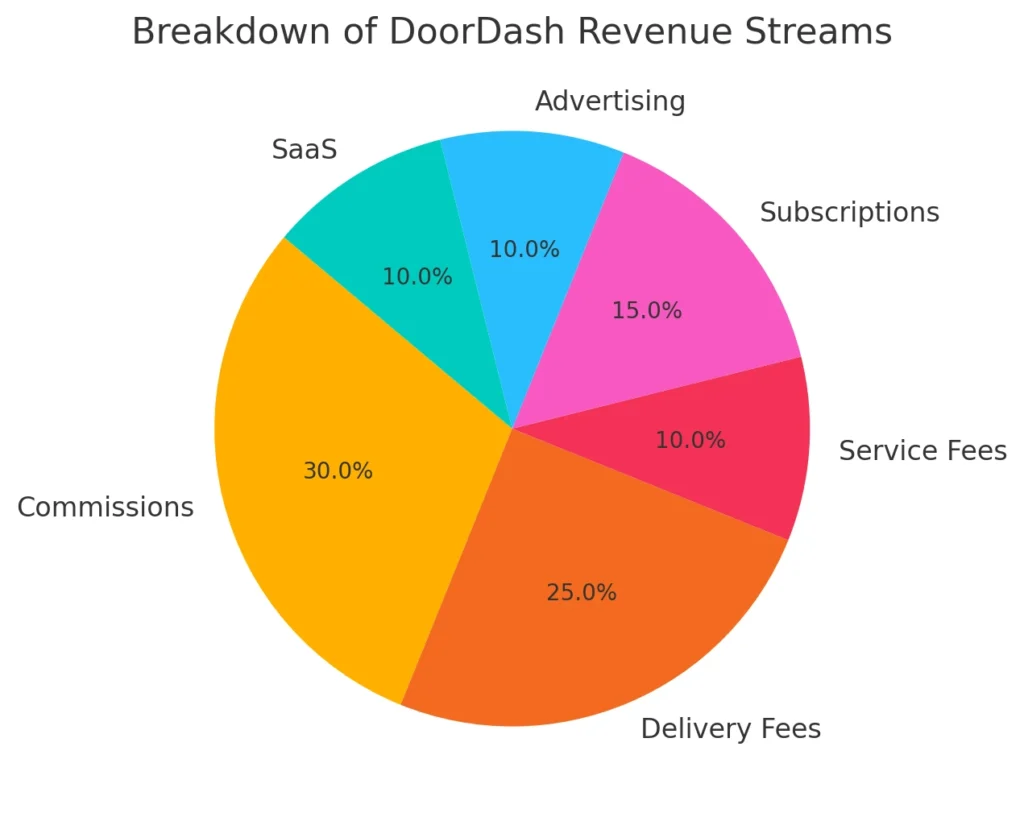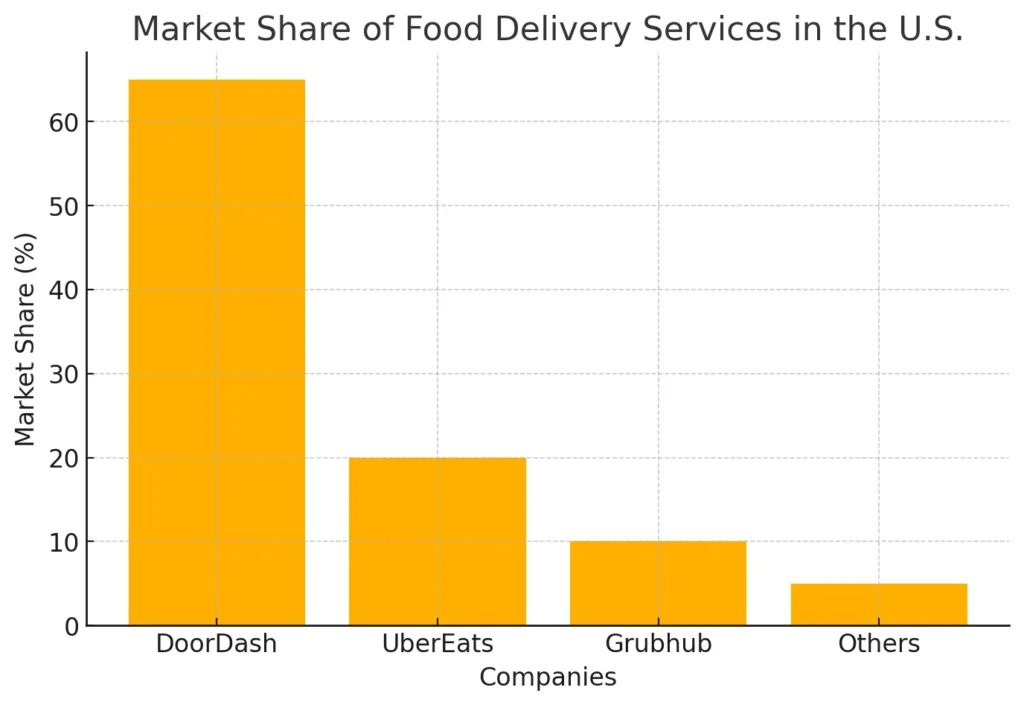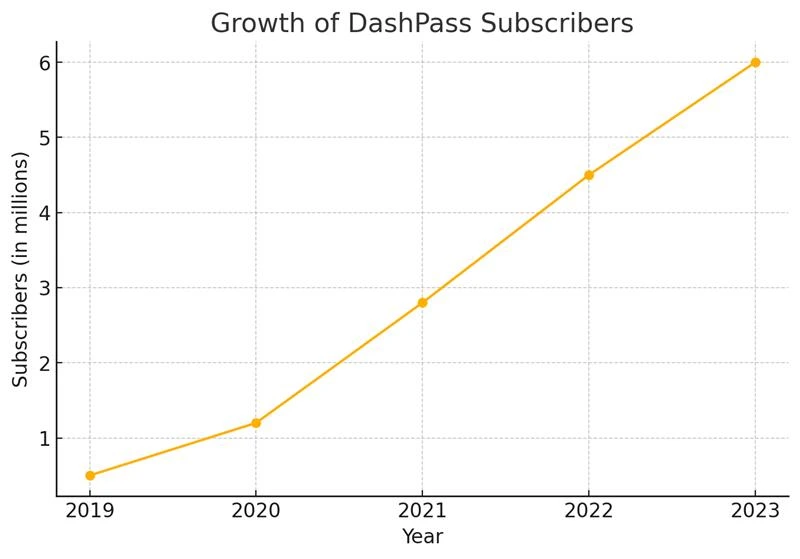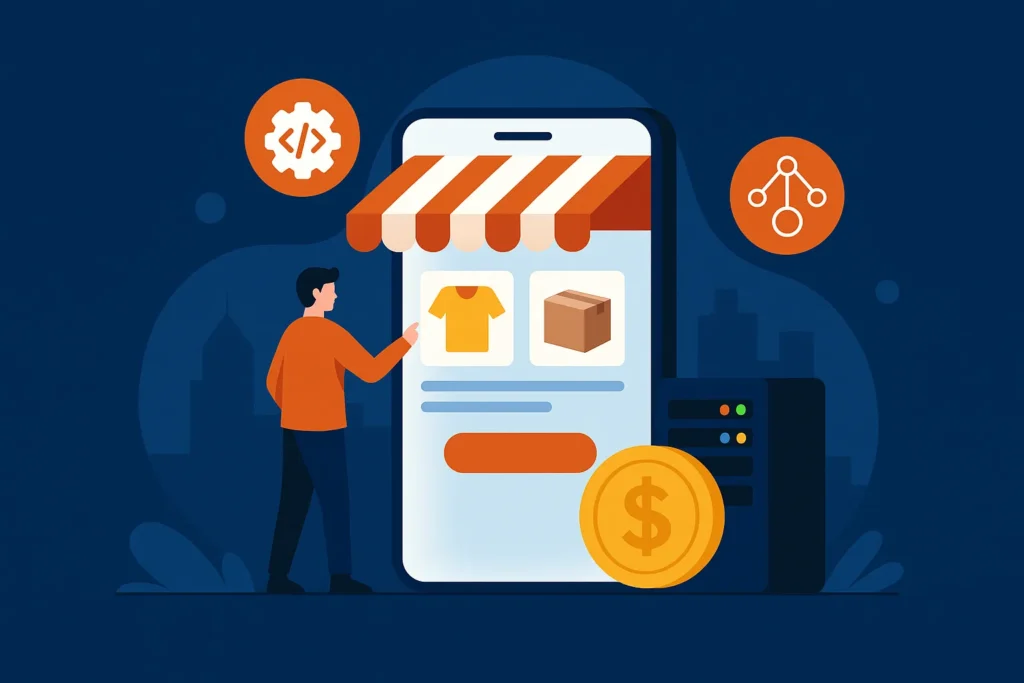DoorDash has emerged as a major force in the on-demand food delivery space, redefining how people connect with restaurants and access meals. Founded by four Stanford students in 2013, the platform has grown rapidly, securing its place as a leader in the U.S. delivery market with a 65% market share.
At the heart of DoorDash’s success lies a well-crafted monetization model. Through a mix of commission structures, delivery fees, advertising, and subscription plans, DoorDash ensures sustainable revenue streams while adding value for customers, restaurants, and delivery partners.
However, the company’s journey hasn’t been without challenges. With increasing competition, labor disputes, and the need to stay relevant in an ever-evolving market, DoorDash continues to adapt, innovate, and expand beyond food delivery into other services. This article dives deep into the strategic elements that shape DoorDash’s monetization success and outlines how the brand remains ahead of the competition. Here You Can Check Our Pre-Built DoorDash App Script
The Growth Story of DoorDash
DoorDash’s rise to the top has been marked by strategic milestones and rapid expansion since its inception in 2013. Originally launched as PaloAltoDelivery, it soon evolved into DoorDash, propelled by funding from Y Combinator. The founders—Tony Xu, Stanley Tang, Andy Fang, and Evan Moore—identified a gap in food delivery logistics and seized the opportunity to build a platform that connects restaurants with customers and delivery agents efficiently.
In the initial phase, DoorDash focused on partnerships with local restaurants that lacked delivery infrastructure. Early funding rounds allowed the company to expand into major U.S. cities like Los Angeles and New York. Over time, acquisitions such as Caviar boosted DoorDash’s market presence by adding high-end restaurant options to its platform.
The company’s growth was not limited to geography. It expanded its offerings from food delivery to include grocery, alcohol, and retail items, enabling it to compete with other services like UberEats and Grubhub. Despite facing challenges, including legal disputes and competition, DoorDash’s ability to innovate helped it maintain its position. Its 2020 IPO was another major milestone, solidifying its dominance as it raised billions for further growth.
DoorDash’s market strategy emphasizes convenience and user experience through technology, such as AI-based order recommendations and live tracking, making it a popular choice among consumers and partners.
During the COVID-19 pandemic, many delivery services, including DoorDash, experienced a significant surge in demand as consumers turned to online food ordering. This shift highlighted the growing reliance on delivery apps, which is reflected in various market analyses. Source: Roam.ai
Ready to disrupt the food delivery market like DoorDash?
We’ll help you design a high-performance app
with top-tier logistics and payment solutions.
DoorDash’s Monetization Strategies

| Revenue Stream | Description | Percentage/Fees |
|---|---|---|
| Commission from Restaurants | Variable fees charged to restaurants for using the platform. | 15% – 30% depending on service tier |
| Delivery Fees | Charges customers for each delivery order placed through the app. | $5 – $8 per order |
| Service Fees | Additional fees on orders to cover operational costs. | Starting at $0.60 |
| Small Order Fees | Fees applied to orders below a certain amount. | Approximately $2.50 |
| DashPass Subscription | Monthly subscription for users to receive free deliveries on eligible orders. | $9.99/month |
| Advertising Services | Fees charged to restaurants for promotional placements on the app. | Varies based on partnership plans |
| SaaS Storefront Fees | Fees for restaurants to manage their own online orders via DoorDash Storefront. | 2.9% + $0.30 per transaction |
The monetization model of DoorDash is multi-layered, ensuring diverse revenue streams from various aspects of its operations. Here’s a detailed breakdown of how DoorDash generates sustainable profits:
- Commission-Based Model
- Restaurants partnering with DoorDash pay a commission fee ranging between 15%-30%, based on selected service tiers (Basic, Plus, or Premier).
- A 6% fee applies for pickup orders, encouraging restaurants to offer self-service options through the platform.
- Delivery Fees
- Customers are charged $5-$8 per order, with fees depending on the delivery distance, location, and order size. This fee structure ensures flexibility and keeps operations scalable during high-demand periods.
- Service and Small Order Fees
- In addition to delivery fees, customers incur service fees starting at $0.60. A small order fee of about $2.50 applies to orders below a minimum threshold to offset operational costs.
- Subscription Model: DashPass
- DashPass offers customers free delivery and reduced service fees on eligible orders for $9.99 per month, increasing user retention through savings on frequent orders.
- Advertising and Marketing Services
- DoorDash provides sponsored placement options for restaurants to boost visibility. Restaurants can select tiered partnership plans to gain marketing benefits.
- Software as a Service (SaaS): Storefront
- With DoorDash Storefront, restaurants can set up custom online ordering systems without commission fees. Merchants pay processing fees of 2.9% + $0.30 per transaction, empowering them with more control over online sales.
These strategies help DoorDash stay profitable while maintaining a competitive edge through innovation and customer-focused offerings.
Also Read:- Build an App Like UberEats
Key Stakeholders in the Business Model
DoorDash’s success lies in effectively integrating three critical stakeholders: customers, restaurants, and delivery partners (Dashers). Each group plays a vital role in the platform’s functionality, and DoorDash ensures all parties benefit.
1. Customers
- Enjoy convenience, live tracking, and personalized recommendations.
- Busy professionals, students, and individuals without cooking facilities find the service especially valuable.
2. Restaurants
- Gain access to DoorDash’s large user base without needing their own delivery network.
- Benefit from tiered marketing options to improve visibility and reach.
3. Delivery Partners (Dashers)
- Dashers appreciate flexible working hours, bonuses, and tips.
- They can choose when and where to work, offering freedom unmatched by traditional employment.
This interconnected system ensures smooth operations, benefiting all participants and contributing to DoorDash’s competitive edge.
Competitive Edge and Market Differentiators

DoorDash’s ability to maintain market dominance hinges on several strategic advantages:
- Y-Structure Business Model
- Seamlessly integrates customers, restaurants, and delivery partners (Dashers), ensuring operational efficiency.
- AI-Driven Features
- Personalized recommendations and dual-rating systems enhance user engagement and satisfaction.
- Service Diversification
- Expands beyond food to offer grocery, alcohol, and retail delivery, creating multiple revenue streams and reducing dependency on a single market segment.
- Innovation in Operations
- Contactless delivery and scheduled ordering keep the platform relevant, especially during unpredictable times like the COVID-19 pandemic.
Also Read:- Build a Food Delivery App Like Zomato
Market Challenges and Sustainability Efforts
Despite its dominance, DoorDash faces several challenges, including:
- Labor Issues and Legal Disputes
- DoorDash has encountered lawsuits related to the classification of delivery drivers as independent contractors, leading to scrutiny over worker rights and compensation.
- Intense Market Competition
- Competing with UberEats, Grubhub, and other platforms requires continuous innovation and effective partnerships.
- Sustainability and COVID-19 Adaptations
- DoorDash responded to the pandemic with initiatives like contactless delivery and waived commissions to support restaurants.
- The company also provided sanitizers and protective equipment to Dashers, reinforcing safety and sustainability practices.
According to Statista, the global online food delivery market is projected to continue growing, emphasizing the competitive landscape DoorDash operates within. The company’s ability to adapt to market fluctuations will be crucial for its sustained success. Source: Statista
Future Outlook and Growth Opportunities

DoorDash’s future is shaped by its ability to innovate and expand across markets. With a successful IPO providing capital for further development, the company aims to penetrate new international markets and explore advanced technologies such as drone delivery.
Additionally, DoorDash is diversifying beyond food delivery into areas like convenience stores, alcohol, and retail services, reducing dependence on a single segment. As competition intensifies, the focus remains on customer retention strategies through DashPass and continued partnerships with local businesses to drive long-term growth.
Also Read:- Top 10 Ideas for Food Delivery Business Startups
Conclusion
DoorDash’s strategic monetization model and innovative approach have solidified its status as a leader in the food delivery market. By leveraging a diverse range of revenue streams, including commissions, delivery fees, and advertising, along with an adaptable business model, DoorDash continues to thrive. The company’s ability to navigate challenges while expanding into new markets and services positions it well for future growth. As DoorDash evolves, it remains committed to enhancing user experience, ensuring customer satisfaction, and exploring sustainable practices that benefit all stakeholders.
This comprehensive examination of DoorDash’s operations offers valuable insights for businesses looking to learn from its successful strategies.
As you explore the innovative monetization strategies behind DoorDash’s success, consider how Miracuves can help your business thrive in the competitive landscape of on-demand delivery services. With our expertise in creating customizable delivery apps, we empower you to develop tailored solutions that meet your unique business needs.
Unlock the potential of your delivery platform with Miracuves—contact us today to get started on your journey towards success!
Ready to customize your food delivery business model?
Customize Your Food Delivery Business Model We’ll help you integrate subscription services, dynamic pricing, and loyalty rewards.
FAQs
What is DoorDash’s primary business model?
DoorDash operates on a Y-structure business model, connecting customers, restaurants, and delivery partners to facilitate food delivery efficiently while generating revenue through commissions, delivery fees, and advertising.
How does DoorDash generate revenue?
DoorDash’s revenue comes from multiple streams, including commissions from restaurants, delivery fees charged to customers, subscription services like DashPass, and advertising for restaurants on its platform.
What are the benefits for restaurants using DoorDash?
Restaurants gain access to a larger customer base, utilize DoorDash’s logistics network for deliveries, and benefit from marketing opportunities without needing their own delivery infrastructure.
What challenges does DoorDash face in the market?
DoorDash encounters challenges such as labor disputes, intense competition from other delivery services, and the need to adapt to changing market conditions, especially during events like the COVID-19 pandemic.
What is DashPass and how does it work?
DashPass is DoorDash’s subscription service that offers users free delivery and reduced service fees on eligible orders for a monthly fee of $9.99, enhancing customer loyalty and encouraging frequent use.







